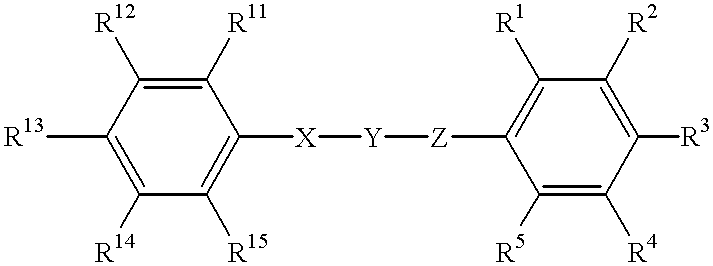Substituted phenyl derivatives, their preparation and use
a technology of phenyl derivatives and substituted phenyl derivatives, which is applied in the field of substituted phenyl derivatives and pharmaceutically acceptable salts, can solve the problems of reducing cell volume, increasing the probability of sickling and thereby of vessel occlusion, and reducing cell volume.
- Summary
- Abstract
- Description
- Claims
- Application Information
AI Technical Summary
Benefits of technology
Problems solved by technology
Method used
Image
Examples
example 2
5-(2-Aminophenyl)tetrazole
2-Aminobenzonitrile (9.44 g, 80 mmol), sodium azide, (6.24 g, 0.1 mol), ammonium chloride (5.12 g, 0.1 mol) and dimethylformamide (50 mL) were mixed and heated at 120.degree. C. overnight. The solvent was evaporated and the residue taken up in water. The crude product was isolated by filtration and recrystallised from water. A yield of 8.4 g of pure product was obtained
Analogously were made:
5-(2-Amino-5-bromophenyl)tetrazole
5-(4-Amino-3-biphenyl)tetrazole
5-(2-Amino-5-nitrophenyl)tetrazole
5-(2-Amino-4-(2-naphthyl)phenyl)tetrazole
5-(2-Amino-4-(3-pyridyl)phenyl)tetrazole
5-(2-Amino-4-(1-naphthyl)phenyl)tetrazole
5-(2-Amino-4-(4-trifluoromethylphenyl)phenyl)tetrazole
5-(2-Amino-4-(3-furyl)phenyl)tetrazole
5-(2-Amino-4-(3-thienyl)phenyl)tetrazole
5-(2-Amino-4-(4-trifluoromethylphenyl)phenyl)tetrazole
5-(2-Amino-4-(3-nitrophenyl)phenyl)tetrazole
5-(2-Amino-4-(4-ethoxycarbonylphenyl)phenyl)tetrazole
5-(2-Amino-4-(4-diethylaminocarbonylphenyl)phenyl)tetrazole
5-(2-Amino-4-(...
example 3
2-Amino-4-phenylbenzonitrile
A mixture of 2-amino-5-bromobenzonitrile (1.0 g, 5 mmol), phenylboronic acid (0.92 g, 7.5 mmol), tetrakis(triphenylphosphine)palladium (50 mg) and potassium carbonate (3.5 g, 25 mmol) in dimethoxyethane / water 2:1 (60 mL) was heated at reflux for 4 hours. After cooling to room temperature the reaction was diluted with water and extracted with ethyl acetate. The organic phase was dried and solvent evaporated. Trituation with petroleum ether gave 0.89 g of the desired compound.
Similarly were made:
2-Amino4-(2-naphthyl)benzonitrile
2-Amino-4-(3-pyridyl)benzonitrile
2-Amino-4-(1 -naphthyl)benzonitrile
2-Amino-4-(4-trifluoromethylphenyl)benzonitrile
2-Amino-4-(3-furyl)benzonitrile
2-Amino-4-(3-thienyl)benzonitrile
2-Amino-4-(3-nitrophenyl)benzonitrile
2-Amino-4-(4-ethoxycarbonylphenyl)benzonitrile
2-Amino-4-(4-diethylaminocarbonylphenyl)benzonitrile
2-Amino-4-(4- aminocarbonylphenyl)benzonitrile
1-(3-Nitro-4-biphenylyl)-1,2-dihydro-1,2,4-triazol-3-one
example 4
3-Trifluoromethylphenyl-4-amino-2-(5-tetrazolyl)phenyl urea
A solution of 3-trifluoromethylphenyl-4-nitro-2-(5-tetrazolyl)phenyl urea (0.8 g, 2.0 mmol) in 96% ethanol was hydrogenated over 5% palladium on charcoal for 3 hours at room temperature. The reaction mixture was filtered through a pad of celite and the solvent evaporated off to give 0.75 g of the desired product. M.p. 175-180.degree. C.
PUM
| Property | Measurement | Unit |
|---|---|---|
| Pharmaceutically acceptable | aaaaa | aaaaa |
Abstract
Description
Claims
Application Information
 Login to View More
Login to View More - R&D
- Intellectual Property
- Life Sciences
- Materials
- Tech Scout
- Unparalleled Data Quality
- Higher Quality Content
- 60% Fewer Hallucinations
Browse by: Latest US Patents, China's latest patents, Technical Efficacy Thesaurus, Application Domain, Technology Topic, Popular Technical Reports.
© 2025 PatSnap. All rights reserved.Legal|Privacy policy|Modern Slavery Act Transparency Statement|Sitemap|About US| Contact US: help@patsnap.com



